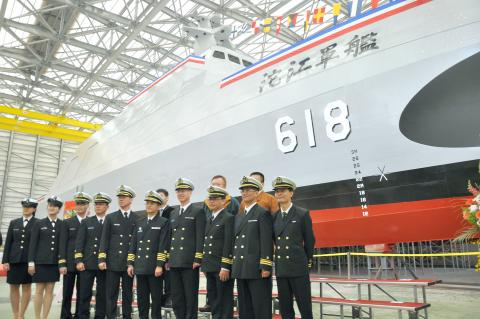The nation’s first stealth missile corvette was christened yesterday — a development that is expected to give the Republic of China Navy (ROCN) the capability to counter larger enemy warships.
The 500-tonne Tuo River (沱江) is the first of possibly 12 ships to be built locally under the Hsun Hai (迅海, Swift Sea) program.
The twin-hull corvette, described as a “carrier-killer” by local media, has a maximum speed of 38 knots (70kph) and a range of 2,000 nautical miles (3,704km). Its speed and low radar signature allows the corvette to get close to enemy targets, experts said.

Photo: CNA
The ship, 60.4m in length and 14m wide, carries a crew of 41. Its armaments include Hsiung Feng II and Hsiung Feng III anti-ship missiles.
The newly developed 500-tonne catamaran had been compared to China’s Type 022 Houbei fast attack missile ship, also a catamaran, due to similarities in their design.
When asked about the comparison yesterday, Republic of China Navy Admiral Chen Yung-kang (陳永康) said the Tuo River missile corvette was “infinitely better” than China’s Type 022.
According to Lung De Shipbuilding Co, the Tuo River is a modulated ship and welded together from 40 separately produced parts and sections.
It is also the first catamaran to be constructed from aluminum alloy.
The missile corvette’s range of 2,000 nautical miles would enable it to make a round-trip patrol from Taiwan to Itu Aba (Taiping Island, 太平島) in the South China Sea, the ROCN said.
The addition of the ship would help greatly in routine patrols to the South China Sea region, it added.
Chen also said the impetus in designing the ship was to produce a highly mobile missile corvette with large missile bays and greater range, and with strong striking and stealth capabilities.
“One of the reasons to emphasize building our own naval warships is to upgrade our overall naval defense capabilities, as well as strengthen the navy’s surface-to-surface combat abilities,” Chen said.
Yesterday’s christening ceremony was held indoors in Suao (蘇澳), Yilan County, and the ship is to undergo final tests and reviews before it is officially launched.
It is expected to be deployed in the first half of next year.
In 2011, the legislature approved a NT$24.98 billion (US$853.4 million) budget to fund the construction of between seven and 11 corvettes, but a fleet of 12 ships is expected to be built.

TRAGEDY STRIKES TAIPEI: The suspect died after falling off a building after he threw smoke grenades into Taipei Main Station and went on a killing spree in Zhongshan A 27-year-old suspect allegedly threw smoke grenades in Taipei Main Station and then proceeded to Zhongshan MRT Station in a random killing spree that resulted in the death of the suspect and two other civilians, and seven injured, including one in critical condition, as of press time last night. The suspect, identified as a man surnamed Chang Wen (張文), allegedly began the attack at Taipei Main Station, the Taipei Fire Department said, adding that it received a report at 5:24pm that smoke grenades had been thrown in the station. One man in his 50s was rushed to hospital after a cardiac arrest

SAFETY FIRST: Double the number of police were deployed at the Taipei Marathon, while other cities released plans to bolster public event safety Authorities across Taiwan have stepped up security measures ahead of Christmas and New Year events, following a knife and smoke bomb attack in Taipei on Friday that left four people dead and 11 injured. In a bid to prevent potential copycat incidents, police deployments have been expanded for large gatherings, transport hubs, and other crowded public spaces, according to official statements from police and city authorities. Taipei Mayor Chiang Wan-an (蔣萬安) said the city has “comprehensively raised security readiness” in crowded areas, increased police deployments with armed officers, and intensified patrols during weekends and nighttime hours. For large-scale events, security checkpoints and explosives

A car bomb killed a senior Russian general in southern Moscow yesterday morning, the latest high-profile army figure to be blown up in a blast that came just hours after Russian and Ukrainian delegates held separate talks in Miami on a plan to end the war. Kyiv has not commented on the incident, but Russian investigators said they were probing whether the blast was “linked” to “Ukrainian special forces.” The attack was similar to other assassinations of generals and pro-war figures that have either been claimed, or are widely believed to have been orchestrated, by Ukraine. Russian Lieutenant General Fanil Sarvarov, 56, head

PUBLIC SAFETY: The premier said that security would be tightened in transport hubs, while President Lai commended the public for their bravery The government is to deploy more police, including rapid response units, in crowded public areas to ensure a swift response to any threats, President William Lai (賴清德) said yesterday after a knife attack killed three people and injured 11 in Taipei the previous day. Lai made the remarks following a briefing by the National Police Agency on the progress of the investigation, saying that the attack underscored the importance of cooperation in public security between the central and local governments. The attack unfolded in the early evening on Friday around Taipei Main Station’s M7 exit and later near the Taipei MRT’s Zhongshan